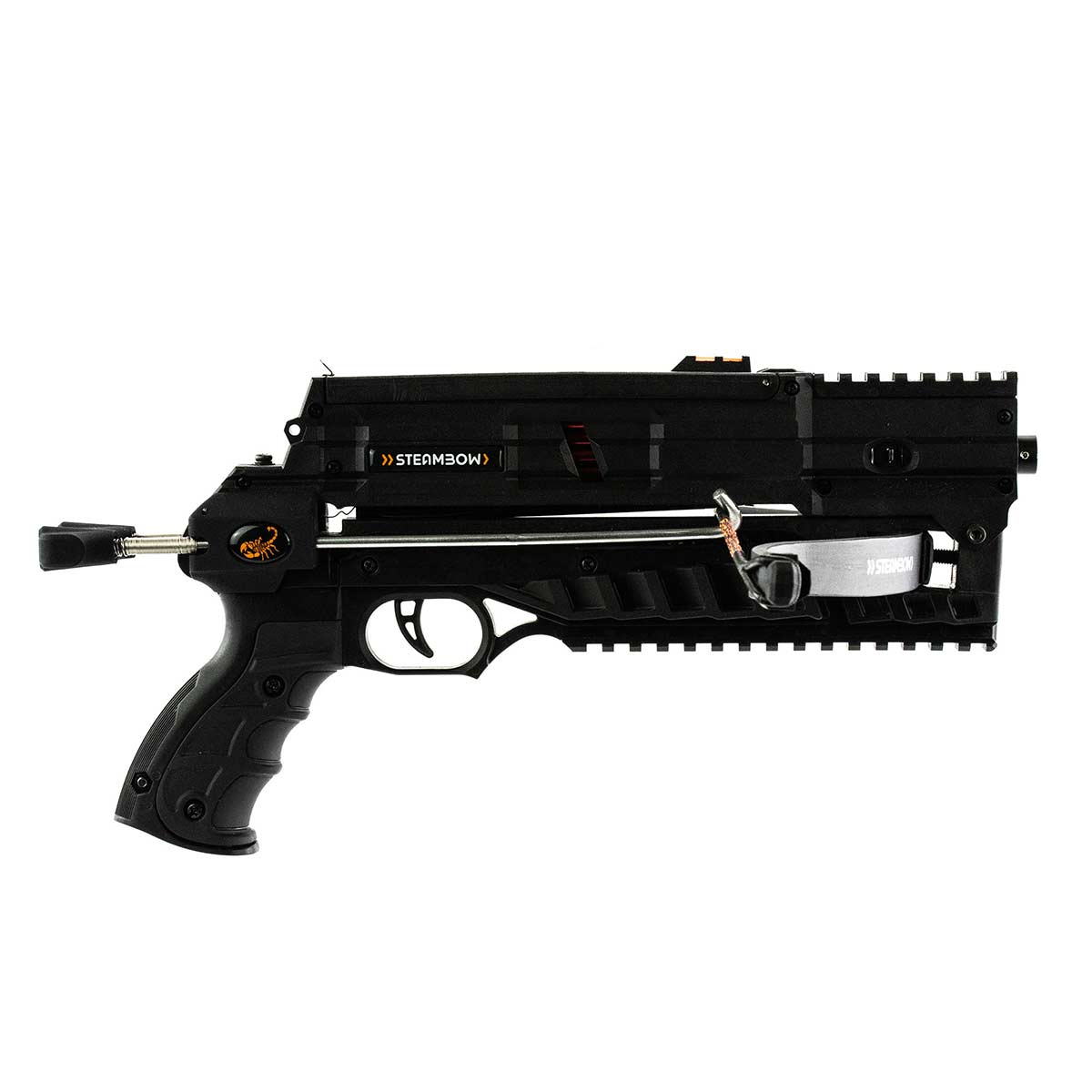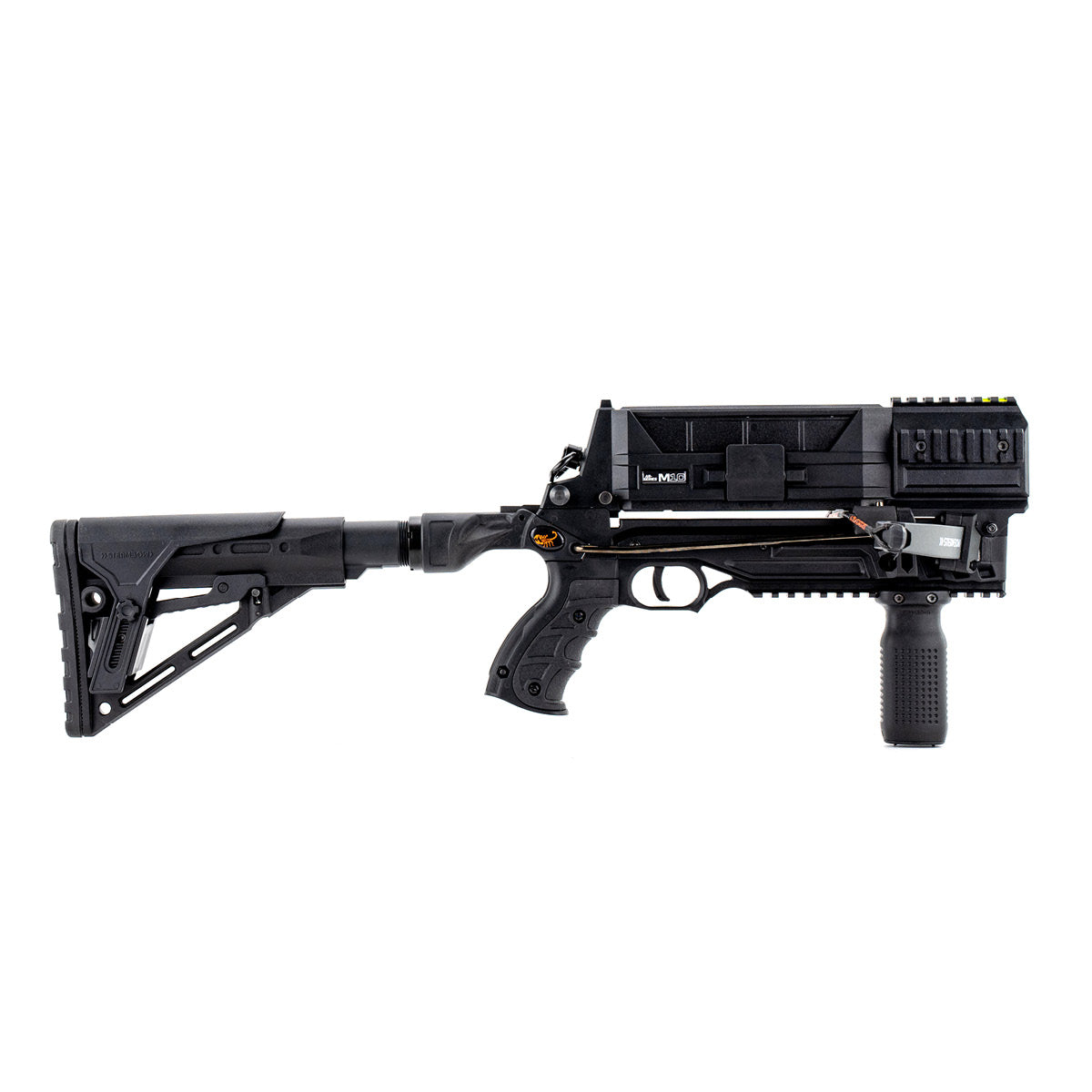The keen observers among followers of Steambow may have noticed a detail that sets some models apart from others: safeties. These reside on the different uppers that Steambow produces. Which lower a given upper is shipped with determines which configuration you have.
The AR-6, integral six-shot upper lacks a safety. As such both the AR-6 Tactical and AR-6 Compact have none. To make firearms comparisons, these two models might seem like somewhat less lethal revolvers: no safety and six shots per reload.
Meanwhile, the scope rail that sets the Survival apart from the other crossbows, and the newest M10 upper, with its detachable box magazine, both have safeties, albeit different in design—in this respect these might have more in common with typical guns for defense that have safeties in the slide. Why is that? After all, it wasn’t by accident. The answer is, as usual with Steambow, practical and commonsensical.
Those who follow Steambow will know this already, but it is worth mentioning again: safety, as a principle and practice, is at the core of Steambow’s approach to the use of its products and archery as a whole. With that in mind, let’s look at this in context.
What are safeties for?
Safeties are essentially there to help avoid an accidental or negligent discharge, to use firearms vocabulary. Note that those two are not the same!
An accidental discharge might be if there is a failure inside the weapon and, in the case of a firearm, the firing pin is released without engaging the trigger. Or perhaps the weapon falls to the ground for some reason, and the impact causes a shot to go off: highly unlikely with modern designs, but not impossible.
A negligent discharge would be more a question of poor weapon handling: leaving your finger on the trigger despite not planning to shoot, or knocking the weapon into an object. If either causes the firing mechanism to activate, you’ve caused a negligent discharge, to give two examples.
Safeties mitigate against that but, as firearms instructors like to point out, the best safety is the one between your ears. In other words, always be vigilant with what you do with your weapon, how you hold it, where you leave it, and in which state, etc.
Why no safety on the AR-6?
With all the above said you might wonder why the AR-6 lacks a safety. There is a reason. First, there is the design. The AR-6 is all about performance without sacrificing reliability. That means that the trigger is a very simple mechanism. Pressing the one-piece trigger basically lifts the string up and out of the catch. That simplicity means the trigger action is relatively heavy. That heaviness drastically reduces the chances of the trigger getting nudged and the bow firing unintentionally.
Beyond that, although often bought for fun, the AR-6 Tactical and Compact were also made for security, and the last thing you need in a high-stress situation is having to fumble with a safety catch when all your fine motor skills have been swept away by a tsunami of adrenaline—this being similar logic to the design of Glock service pistols, and one of the reasons they are popular with many owners in the US looking for a home defense gun.
Then, why have a safety on the M10 Tactical and Survival?
With the M10 Tactical and the Survival, again purpose comes into play. In the case of the Survival, it is designed as a small, portable, and dismantlable hunting crossbow. A safety is important in a hunting situation as there are endless twigs and branches all eager to get stuck in your trigger guard, and if you are worrying about them, you can’t focus on the furry supper you are trying to get closer to.
For the M10, the reason differs. Although the M10 is an excellent choice for the fun and the personal home security aspects, it also fits an activity that the AR-6 crossbows cannot: dynamic crossbow shooting. In such competitions, the rules will specify that a safety be part of eligible weapon systems or you risk being excluded from certain categories.
Prior to starting a course of fire, the safety can be on “safe” until the timer sounds the start. Once flipped to “fire,” the shooter can start engaging targets and racking up points. Logically, the safety is manually engaged, otherwise that shooter would lose precious time, disengaging the safety with every cocking cycle.
There is another reason too. In the same way that the heavy “duty trigger” of the AR-6 Tactical made the need for a safety catch less pressing, the M10 Tactical ships with the more competition-friendly tuning trigger, which is far more sensitive and light. As such it would be far easier to cause a shot if something nudged the trigger once cocked, regardless of how high the draw weight being used.
All going well, the above information will help you better choose the model best for you, and encourage you to always be careful of how you handle your AR-Series repeating crossbow of choice. To see them in more detail, have a look in the web shop or click on the links above.





